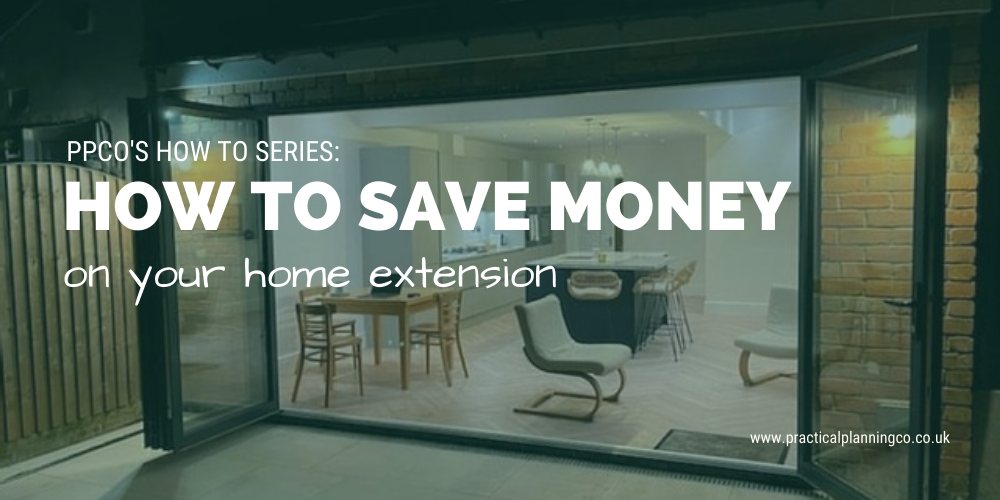How to save money on your home extension
When it comes to home extensions, what homeowners can afford doesn’t always match up to their expectations, wants or needs.
Many of our clients are surprised to hear just how much their new extension is going to cost. That’s why it’s so easy to go over budget. But the most important thing you can do is set a budget at the beginning - and stick to it!
For home extension projects, you’ll need to factor in fees for architectural plans, planning permission (if it’s required), building control and structural calculations (again, if they’re required) on top of your build cost. Then you’ve got fixtures and fittings. And it’s important to factor in a contingency (around 10%) to cover any unexpected costs.
As you can see, those costs soon start to add up. While it’s important not to cut corners, there are several things you can do to cut costs, especially when it comes to the design.
Read on to find out where you should spend money, and where you can save some pennies to keep your extension costs down and remain in control of your budget.
Choose your designer - or architect - carefully
You might be tempted to try and go without a designer on a simple job but it can really pay off to work with a professional. Professionally produced drawings will clearly detail all the elements that need to be considered and included. The more detail there is, the smaller the chance of your project veering off course - and over budget.
Spend time choosing your designer or architect (find out the key differences between them and how to find the right one here) carefully. If you find the right person - or company - they’ll help you keep costs down. Find somebody who has a track record of producing plans for low-cost projects and do your research. Look for a good online presence with plenty of good reviews - or better yet, ask for references.
Tell your designer your budget
Make sure you tell your architectural designer (or architect) what your budget is and what your priorities are right at the very beginning so they can help you get the most for your money.
If you’re able to confirm your budget with your designer at the start, it’s going to take less time to get your architectural plans finalised. And they’re not going to draw up something you can’t afford, only for you to then have lots of back and forth to get a final result you’re happy with. And there’s no point gaining planning permission for a double storey side extension when you can only afford a single storey – for which you might not have even needed permission in the first place.
Our design package fees are completely fixed so if you work with us, you’ll know what your design costs will be from the beginning - and there’s no danger of them creeping up!
Only build what you need
Consider how much space you really need. It might be possible to extend out by 8m (on a detached property) and across the width of your property with prior approval but a smaller space might make more sense. Just because you can doesn’t mean you should! The bigger you go, the higher the build cost and if you can keep it within permitted development, you save cash AND time.
A smaller space may suit all your requirements while coming in under budget, allowing you to spend a bit extra on something you’re going to get real benefit from - such as bi-folding doors, or a top-of-the-range oven.
A good estimate for working out what you can afford to build is £1,500 per square metre for ground floor and £1,100 per square metre for upper floors. Finishing would be on top of this e.g. bathrooms, kitchens, carpet etc.
Don’t be overly ambitious
What you need and want at the moment will likely change in 10 or 20 years. So, don’t feel like this home has to have every feature or the exact space you’ll ever want.
Create a space and home that will make you happy now. That’s all that really matters.
Keep it simple
Start your design process from the most cost-effective option or space and then work up.
For example, a rectangular or square footprint extension with a flat roof will likely be the cheapest design. And, if you use nibs, rather than having your walls flush, you could save around £5-6k. Then you can start to add features like roof lights or lanterns, and look at a few of your priorities. Bi folds tend to be the dream aesthetic, but they can be expensive, coming in at around £3k, as opposed to half that for traditional French doors. You might need to decide what’s more important - the dream doors or the dream kitchen, for example.
Speak to your neighbours
Communication with neighbours is vital and, depending on the work you’re carrying out, you may be obligated to give eight weeks’ notice to your neighbour (or neighbours) in writing under something called The Party Wall Act - find out more here - before your build starts. If you can handle this yourself and get them to reply in writing that they have no objections, you can avoid having to pay for a party wall surveyor, who can charge £100s if not £1,000s.
Reuse materials
One of the best ways to keep costs down with kitchen extensions especially is to reuse units where you can - and just replace the doors and countertops etc.
The same applies to old floorboards and doors, for example.
Pick up a shovel
Labour costs represent a HUGE chunk of your build cost, which means you can make a great saving if you’re able to do some of the work yourself.
We don’t advise you take on work you don’t have the time or skills for but some of the easiest jobs you could do are simple labouring, decorating and landscaping.
And if you’re able to manage the project yourself - like this client did - working with several different tradespeople rather than hiring one contractor to manage it for you, you could save around 15%. Although it’s recommendable that you have some knowledge of construction - and lots of time! - to do this successfully.
We’ve all heard those of those Grand Designs budgets falling apart but your dream home extension shouldn’t come at a price. So, start small: plan and build something you can afford. Create a design that’s practical, which gives you the space you need and a few of the features you desire.
If you’re based in the East Midlands and you’d like to book in with our Nottingham team for a free, no obligation design consultation where we can chat about your home extension, please give us a call on 0115 874 8570 - or hit the button below.
If you’re not quite ready to get started, or you’re based elsewhere in the UK, please feel free to check out the rest of our Advice Centre - and connect with us on Instagram and Facebook for tips and inspiration.
Other useful articles
5 things you need to do when planning a home extension
The true cost of a home extension

